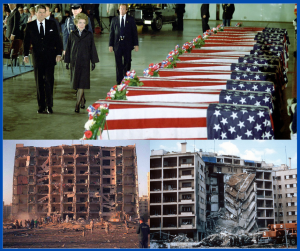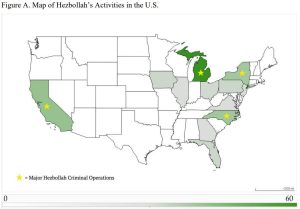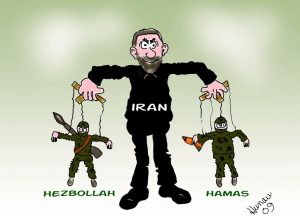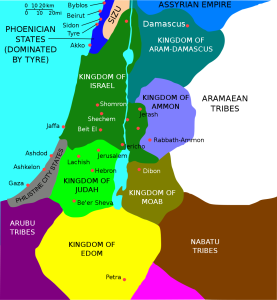
See our “Dispelling Falsehoods, Stating Facts” section to help address difficult questions about the conflict.

Communities in northern Israel are virtually ghost towns, while the world’s attention is focused on the war in Gaza. Those towns in the north mirror the villages near Gaza that were decimated and evacuated on 10/7. The Iran-backed terrorist organization Hezbollah has fired hundreds of lethal rockets at Israeli civilians and soldiers in solidarity with Hamas. These heavily-armed and well-funded terrorists are primarily viewed as an existential threat to Israel, but they also have killed hundreds of Americans across the Middle East, while raising funds in America with plans to carry out future attacks in the U.S. This serves Iran’s ideology of attacking ‘Big Satan’ and ‘Little Satan,’ America and Israel.
‘Rockets don’t discriminate between Arabs and Jews’
Most Hezbollah rocket, missile and drone strikes intentionally target Israel’s northern cities; 16 Israeli civilians and soldiers have been killed since 10/7. A barrage of 60 Katyusha rockets fired on Feb. 26 forced Israelis to run for safety. These deadly attacks and threats of escalation forced Israel’s government to evacuate hundreds of thousands of civilians from cities, towns and villages along its border with Lebanon.
Israelis living in the north represent the country’s religious and ethnic diversity: Jews, Muslims, Christians, Arabs, Bedouin and Druze. Arab al-Aramshe is a Bedouin Arab village situated right on the northern border. During the war Hezbollah launched against Israel in 2006, a terrorist bomb fell in the garden of a family home, killing a Bedouin mother and her two daughters. Current resident, Ali Mohamid, 68, who was evacuated in the current war, stressed to The New York Times that rockets “don’t discriminate between the blood of Arabs and the blood of Jews.”
Hezbollah recently launched a rocket barrage against the largest border city in northern Israel where one rocket smashed through the wall of a local mall. Ricky Hadad, a refugee mother of seven, attempted to move back permanently despite the evacuation orders: “I’m too scared, the rockets freak me out and I can’t sleep. On some nights I ended up calling one of my children in panic to come get me out of here. So I’m returning to the hotel in Tel Aviv even though being there depresses me. I’m climbing up the walls.”
Hezbollah presents a far greater threat to Israel than Hamas. Iran has supplied it with a stockpile of more than 100,000 rockets aimed at Israel, many capable of striking anywhere in the country. These missiles have more destructive power, better technology and can reach farther than the low-grade rockets fired by Hamas in Gaza. Hezbollah also has built a vast tunnel network far more sophisticated than Hamas. Israel’s army, air force and navy have carried out drills in preparation for a wider-scale war with Hezbollah. The Israeli Defense Forces have responded to the attacks against Israelis by striking Hezbollah, Syrian and Iranian targets in Lebanon and Syria.
Hezbollah Poses a Direct Threat to America
U.S. intelligence officials recently warned that Hezbollah is capable of attacking the American homeland. The news report, published in Politico, describes Hezbollah’s “expansive international network of operatives that could carry out an attack in the U.S.” A 2022 security review of Hezbollah-affiliated activity in America revealed that more than 100 individuals have been sentenced for providing support, mainly in money laundering and smuggling of goods.
The FBI’s Joint Terrorism Task Force arrested two trained Hezbollah agents in America in 2017 after they carried out surveillance of potential targets. A former defense dept. official recently stated that “we should expect Iran-backed attacks on U.S. soldiers to resume, mostly because we know that Iran continues to arm, fund and train these groups.”
Hezbollah has attacked American citizens in the bombing of the U.S. Embassy in Beirut in 1983, killing 63, including 17 Americans; the U.S. Marine barracks bombing in October 1983 which killed 241 American and 58 French servicemen; the bombing of the U.S. Embassy annex in Beirut in 1984 which killed 24; the hijacking of TWA 847 in 1985 in which a Navy diver was shot in the head and his body dumped on the tarmac; and the Khobar Towers housing attack in Saudi Arabia in 1996 that killed 19 U.S. airmen. The Office of the Director of National Intelligence has an interactive timeline of Hezbollah’s worldwide operations.

President Ronald Reagan and Nancy Reagan honor the victims of U.S. Embassy bombing in Beirut, Lebanon, shown on the bottom right. The other image is the aftermath of the Khobar Towers housing complex bombing.
Iran Arms, Trains and Funds Hezbollah
The 1979 Iranian Revolution transformed a secular country into the Islamic Republic of Iran. After the revolution, Iran aligned itself with groups sharing its ideology. Lebanon, with a government weakened by years of civil war, became an easy target for Iran to prop up the fledgling Hezbolah. With its large Shi’ite population and proximity to Israel, it was a natural target for Iranian influence. Most Muslims are Sunni; Iranians are a notable exception. The ensuing radicalization of Lebanon also transformed the country, including the fleeing of much of its Christian population.
Hezbollah – literally “Party of God” – is a Shiite Islamist terrorist organization. Its name was chosen by Iran’s first supreme leader, Ayatollah Khomeini. It was founded in the 1980s during the Lebanese Civil War, initially to fight against the IDF in southern Lebanon. This region was a launching pad for attacks against Israel by the Palestine Liberation Organization terrorist group, led by Yasser Arafat. The IDF entered Lebanon in Operation Peace for the Galilee to target the PLO and end attacks that had killed Israelis. Israeli forces remained until a unilateral withdrawal in the summer of 2000.
Hezbollah launched a cross-border attack in 2006, capturing two Israeli soldiers and killing three others. This assault led to the month-long Second Lebanon War. Hezbollah fired about 4,000 rockets at Israeli cities, more than 100 per day. Following the end of the war, Hezbollah continued to increase its rocket arsenal with deadlier, long-range weapons, most supplied by Iran. The terror group also fights alongside the Syrian government and other Iran-backed groups in the Syrian Civil War. Syria borders Israel.
Iran-backed Hezbollah also has significant terrorist and financial operations in South America. Hezbollah carried out the 1994 bombing of the AMIA Jewish Community Center, as directed by Iran. A suicide bomber drove a van loaded with 600 pounds of fertilizer and oil into the Jewish hub in Buenos Aires, killing 85 people. A day after the attack, a suicide attacker detonated a bomb on a Panamanian plane that killed all 21 passengers, including 12 Jews. Hezbollah also carried out a bus bombing in Bulgaria, which killed six Israelis in 2012, including a pregnant mother.

================================================

1. Hezbollah is an existential threat to Israel’s security
Hezbollah is backed by Iran, armed with an extensive rocket, missile and drone arsenal and has a large, trained fighting force many times larger than Hamas terrorists. Hezbollah terrorists have the capability to launch rocket attacks, conduct cross-border raids and engage in terrorist activities against Israel from southern Lebanon far more destructive than the surprise attack of 10/7 from Gaza. Its more than 100,000 rockets are capable of reaching every major Israeli city. Hezbollah’s involvement in the Syrian conflict has increased its operational experience and magnified its threat. It has links to other regional terrorist groups – notably Hamas. Hezbollah’s aggressive posture and advanced weaponry make it a formidable adversary for Israel, requiring constant vigilance and robust defense measures.
2. Israelis cannot live in peace under the threat of rocket attacks
Hezbollah has launched numerous attacks against Israel in the past, resulting in civilian casualties and widespread fear. The prospect of sudden rocket fire, with little warning, creates a constant sense of vulnerability and insecurity among Israelis living near the border with Lebanon. It disrupts daily life, limits economic opportunities and has a profound psychological impact on individuals and communities. To truly achieve peace, this threat must be addressed and neutralized, ensuring the safety and security of all Israelis and their Lebanese neighbors.
3. Iran is an international terrorist mastermind
Iran finances, trains and arms numerous regional terrorist organizations – including Hezbollah, Hamas, Palestinian Islamic Jihad and Yemen’s Houthis who are now attacking commercial ships in the Red Sea. Iran leverages these proxy groups to advance its own interests and challenge its adversaries, notably Israel and America. Iran’s sponsorship of terrorism also is a major concern for regional stability and security in the Middle East, as it fuels conflict and undermines efforts to promote peace. The Abraham Accords were launched, in large part, to form an alliance between Israel and its Arab partners against Iranian aggression.
4. Hezbollah and Iran are a threat to America
Iran-backed Hezbollah has an extensive global network and history of terrorist activities against Americans and Jews worldwide. Hezbollah and Iran leverage their network of deadly resources to carry out attacks against American targets both at home and abroad. Iran – as a state sponsor of terrorism – provides financial, logistical and ideological support to Hezbollah. Iran’s pursuit of nuclear weapons and aggressive rhetoric toward the U.S. increase the potential for conflict. The U.S. must remain vigilant and work with its close allies – including Israel – to counter the ominous threat posed by Hezbollah and Iran.

Cartoon by Barry Hunau
REALITY: Before the creation of the modern Jewish state in 1948, there was a series of violent attacks against Jews by Arabs. The most notorious example was the massacre of 68 innocent civilian Jews in Hebron in 1929. During this riot, dozens were seriously injured, and Jewish homes and synagogues were attacked. Similar to now, they were incited by false stories about Jews and Jerusalem’s Al Aqsa Mosque. The Mufti of Jerusalem, Amin al-Husseini, collaborated with Hitler. Jews were attacked from the West Bank and Gaza before Israel controlled them. Jews were attacked before the creation of settlements. Israel is not the reason for attacks; anti-Jewish hate, indoctrination and incitement are the root causes.
———————————————————————————–
REALITY: Jews are from Judea. In Hebrew, Jew is Yehudi and Judea is Yehuda. Judea is the ancestral home of the Jewish people. Now, the regions Judea and Samaria are known as the West Bank. Even though this land is of historical and cultural importance, Israel has continued to negotiate the establishment of a Palestinian state in the historical homeland of Jews in return for the right to live in peace.

A map of the Levant, circa 830 BCE. Now, this map represents Israel, the West Bank, Gaza, Egypt, Jordan, Syria and Lebanon.
———————————————————————————–
REALITY: Israel is the ancestral home of the Jewish people. Jews were exiled from the Jewish homeland, moving around the world just like other nationalities. Ashkenazi Jews were centered in Europe, Sephardic Jews in Spain and Mizrahi Jews in Islamic countries across the Middle East and North Africa. Anti-Israel activists try to paint all Israeli Jews as ‘white’ Ashkenazi Jews. They state that Israelis should move back to Europe. A majority of Israeli Jews are Mizrahi. Their families lived in neighboring countries for centuries before they were largely forced out after Israel’s creation. The ethnic cleansing of 750,000 Jews from Arab countries is often overlooked.
================================================

Help educate others about key terms and concepts in this war
Every conversation is an opportunity to educate and inform. The more individuals know and understand, the less inclined they will be to follow false and biased narratives. Take active steps to educate your friends and family about the Hamas war against Israel, including using these talking points. Share relevant news articles, videos and Middle East history to help provide a comprehensive understanding of the war’s complexities. Engage in open and respectful discussions, emphasizing the nuances of the situation and encouraging critical thinking.
———————————————————————————–
Palestinian Voices Against Hamas
Palestinians in Jabalia, Gaza, recently have been protesting against Hamas. They chanted against Hamas leaders: “Sinwar and Haniyeh, the people are the victims. Down with Hamas.” Hamas responded by shooting at the protestors.
One of the protestors spoke out: “This is the revolution of the people of Jabalya, the revolution of northern Gaza. You hear it? Hamas are shooting at us. Have they no shame?
They got us into a war we don’t want. We want peace. We want our children to go to school. Our children shouldn’t be displaced. They should not live in the streets. Who is responsible for all these things? Why is Hamas doing this? They are shooting at people. Why? Because they are hungry? They are shooting at people because they are hungry? [Hamas leader] Sinwar, what gives you the right to kill your own people?
Sinwar, it is you that is killing us, not the Israeli army. It is you who is killing us. Shame on you, Hamas. Listen to this. This is direct shooting. While I am talking to you, Hamas is shooting at hungry protesters.”
================================================

Stories Impacting the U.S. and Israel
Stories Impacting American Jews
================================================
———————————————————————————–
This content is developed by The Focus Project in partnership with Mercaz USA. The Focus Project distributes weekly news and talking points on timely issues concerning Israel and the Jewish people, including antisemitism, anti-Zionism and the delegitimization of Israel. It represents a consensus view across a spectrum of major American Jewish organizations. Mercaz USA recognizes and respects the diversity of views on these issues among its readers and the community at large.